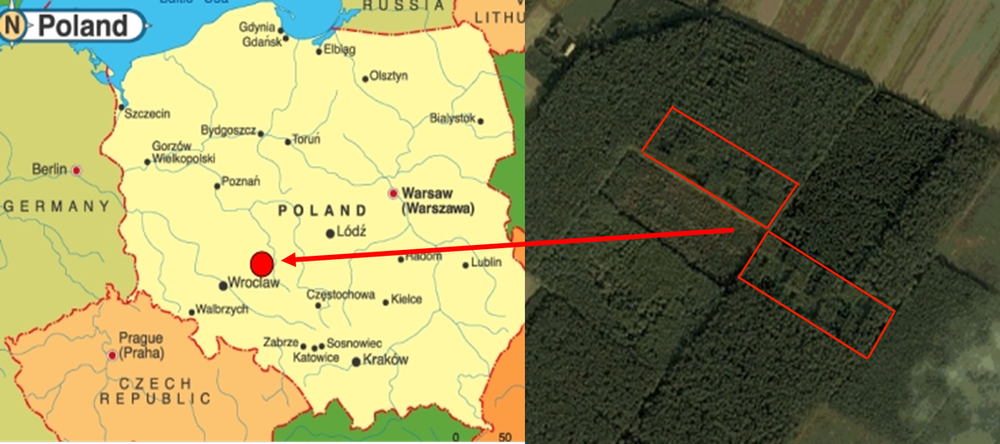Factors influencing fine root decomposition - Belowground carbon sequestration and nutrient cycling in temperate forest ecosystems

Common garden of 14 tree species in Poland
Collaborators: Douglas Archibald, Sarah Hobbie, Jacek Oleksyn, Peter Reich, Bartosz Bulaj, Johanna Mucha, Marcin Zadworny
Present address:
Research Associate, Department of Natural Resources, Cornell University.
Email: mg567@cornell.edu
Personal webpage:
http://blogs.cornell.edu/marcgoebel
Marc was partially supported by the National Science Foundation, College of Agricultural Sciences, Plant Science Department and the Ecology Program.
Biological processes belowground promote carbon and nutrient cycling and therefore influence the productivity, structure, and diversity of plant communities. In a variety of plant communities, the belowground net primary production is at least that of aboveground, contributing significantly to the recycling of plant tissue-bound carbon and nutrients into the soil through fine root decomposition. A common garden approach of 14 tree species will be used to investigate (1) the impact of species-specific differences in structural and functional characteristics of fine root orders on the process of decomposition among temperate tree species and (2) predict rates of in situ root decomposition based on initial root tissue quality and soil characteristics. Based on age and functional differences fine root tissues vary in quality and anatomical characteristics. Under the assumption that root tissues with different anatomy and tissue quality decompose at different rates, I stratified fine roots (< 1 mm) by root order and placed them into separate compartments of root litterbags over the time period of three years. The goal of this experiment is to examine if rates of carbon and nutrient cycling vary among root orders of fine roots less than 1 mm.
In addition to the root litterbag study, I observed undisturbed fine roots in situ, severed from the stem, using minirhizotron technology. Vital staining was used to refine estimates of the death of roots based on external appearance, which was then used with minirhizotron images of roots severed from the stem. Rates of decomposition will be estimated from the duration between root death and total disappearance of fine roots. Previous research on root decomposition, using roots with a diameter less than 2 mm showed that certain factors of root tissues are more influential during decay than others. The analysis of decayed root orders for the content of carbon, nitrogen, calcium, magnesium, phosphorous and aluminum, as well as, esterfied phenolics and the lignin content will allow a detailed evaluation of these intrinsic factors. In addition, I will examine the relationship of soil properties, the extrinsic factors, collected for each plot of the common garden setting, to further improve the analytical power of my research.
Ultimately, the comparison of two belowground methods examining rates of decomposition by root order will provide better understanding of belowground decomposition processes among different temperate tree species.
Publications:
Goebel, M., Hobbie, S.E., Bulaj, B., Zadworny, M., Archibald, D.D., Oleksyn, J., Reich, P.B., and D.M. Eissenstat. 2011. Decomposition of the finest root branching orders: Linking carbon and nutrient dynamics belowground to fine root function and structure. Ecological Monographs 81:89-102
Smart DR, E. Carlisle, M. Goebel, & B. A. Nunrz. 2005. Transverse hydraulic redistribution by a grapevine. Plant, Cell and Environment 28, 157-166.
Smart DR, C. Stockert, T. L. Bauerle, E. Carlisle, and M. Goebel (2005) Articfacts of grapevine root proliferation following installation of minirhizotron observation tubes.
Acta Horticulture (ISHS) 689:153-158.
Manuscripts
A. Atucha, I.A. Merwin, M.G. Brown, F. Gardiazabal, F. Mena, C. Adriazola, M. Goebel and T. Bauerle (submitted). Root distribution and demography in an avocado orchard under groundcover management systems.
M. Goebel, S.E. Hobbie, M. Zadworny, J. Mucha, B. Bulaj, J. Oleksyn, P.B. Reich, and D.M. Eissenstat. (in prep) Patterns of decomposition of undisturbed fine roots among temperate tree species in an experimental forest in southwestern Poland
J.M. Withington, M. Goebel, J. Oleksyn, P. B. Reich, D. M. Eissenstat. (in prep) Phenology and growth periodicity of finest roots among 11 tree species in a seven-year study
M. Goebel, E. Fares, D.D. Archibald, D.M. Eissenstat. (in prep) FTIR analysis of lignin content in very small root order specimens over a three year decomposition period

